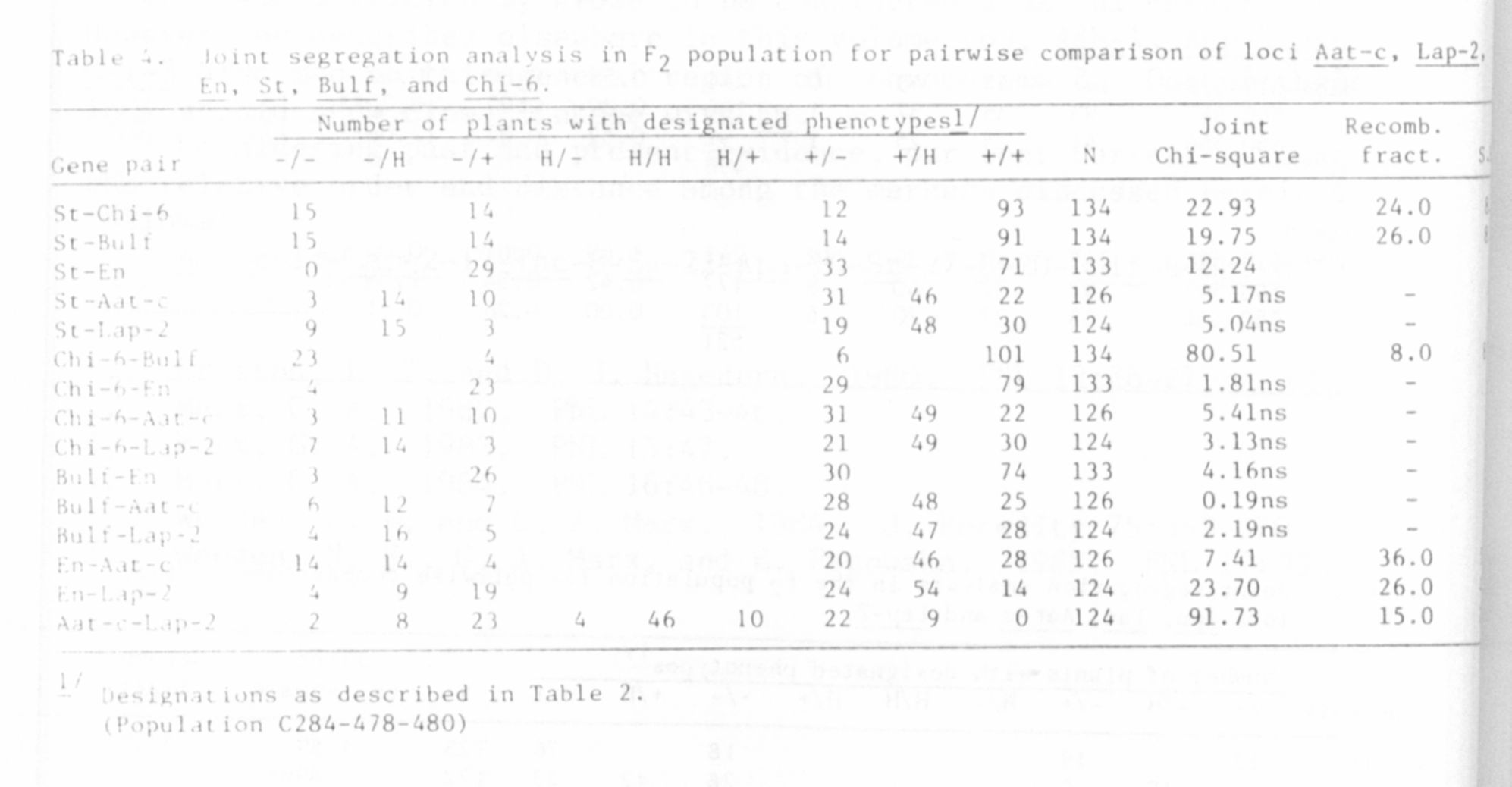PNL Volume 17 1985
RESEARCH REPORTS 59


|
|
|||
|
PNL Volume 17 1985
|
RESEARCH REPORTS 57
|
||
|
|
|||
|
LINKAGE RELATIONSHIPS AMONG MARKERS IN CHROMOSOME 3 AND En, A GENE
CONFERRING VIRUS RESISTANCE
Marx, G. A., N. F. Weeden, and R. Provvidenti
NYS Agricultural Experiment Station, Geneva, NY USA
Two excellent seedling markers, apu and tac, recently were reported
to be situated in chromosome 3, linked with st (4). The data did not
reveal, however, if apu and tac lie towards the b or the M end of the
chromosome, so new linkage tests were performed using b as an additional
marker. F2 populations from the following crosses were scored in the
field in 1984 ( only the relevant genes being listed):
A B_ St apu Tac x A b st Apu tac (and reciprocal)
a B St apu tac x b st Apu Tac
a B St apu tac x A b st Apu Tac
The analysis (Table 1) confirms the placement of apu and tac in
chromosome 3 and localizes tac in the M end of the chromosome. Although
the orientation of apu is somewhat unclear from these data, the overall
body of evidence indicates that apu also lies on the M side of st.
These findings, together with results from previous studies of
chromosome 3 (2, 3), make it evident that suitable seedling markers are
favorably spaced over nearly the entire length of the chromosome. This
set the stage for three further linkage tests conducted in the green-
house in the fall of 1984. They were designed to establish the rela-
tionships among morphological markers, certain isozyme markers, and the
gene En conferring resistance to pea enation mosaic virus (PEMV).
Initially we determined the relationship between three morpholo-
gical markers, st, apu, and tac, and two isozyme markers, Lap-2 and
Aat-c (Table 2). Gel electrophoresis was performed using methods
previously described (5). Linkage between Aat-c and Lap-2 is evident.
Moreover, both isozyme markers showed linkage with tac and both evi-
dently lie distal to tac.
|
|||
|
|
|||
|
|
||||
|
58
|
PNL Volume 17 1985
|
RESEARCH REPORTS
|
||
|
|
||||
|
In the second and third greenhouse experiments the F2 populations
segregated for resistance (En) and susceptibility (en) to PEMV. Gritton
and Hagedorn (1) and D. W. Barton (unpublished) earlier had found lin-
kage between En and st. En was believed to be in the M arm of
chromosome 3, but because there was no certainty of this, we used a line
carrying a morphological marker (chi-6) known to be located distal to b.
(2). The cross had the formula:
En Tac Apu st chi-6 x en tac apu St Chi-6
Seedling F2 plants were inoculated in the two-three leaf stage by rub-
bing the leaves with a known culture of PEMV. A week later the plants
were inoculated again to ensure against escapes. Analysis of this cross
revealed that En and tac are rather tightly linked ( - 8 units),
verifying that the En locus resides in the M end of chromosome 3
(Table.3).
The third of the three greenhouse experiments involved the cross:
Aat-c(S) Lap-2(S) En st chi-6 bulf x Aat-c(F) Lap-2(F) en St Chi-6 Bulf
In this case the M end of chromosome 3 was marked only with isozyme
variants and the b end was marked by morphological genes. The rela-
tionships among the genes segregating in this cross (Table 4) were con-
sistent with expectation. However, the St-En relationship is probably
anomalous because the genes were in repulsion and the population size
was small. Although both Aat-c and Lap-2 showed linkage with En,
neither was sufficiently close to be considered a useful marker for En.
However, as described elsewhere in this volume (6), Adh-1, Acp-3 and
Gal-3 also map to this general region of chromosome 3. One of these
loci should show close linkage with En.
Considering past and present evidence, our best current estimate of
the relative order and distance among the markers discussed herein is as
follows:
Aat-c-ll-Lap-2-17-Tac-8-En-22-Apu-10-St-27-B-20-Bulf-8-Chi-6
|
||||
|
|
||||
|
1. Gritton, E. T. and D. J. Hagedorn. 1980. PNL 12:26-27.
2. Marx, G. A. 1982. PNL 14:43-46.
3. Marx, G. A. 1983. PNL 15:47.
4. Marx, G. A. 1984. PNL 16:46-48.
5. Weeden, N. F. and G. A. Marx. 1984. J. Heredity 75:365-370.
6. Weeden, N. F., G. A. Marx, and E. Pagowska. 1985. PNL 17:75-76.
|
||||
|
|
||||
|
|
|||
|
PNL Volume 17 1985
|
RESEARCH REPORTS 59
|
||
|
|
|||
 |
|||
|
|
|||
 |
|||
|
|
|||
|
|
||||
|
60
|
PNL Volume 17 1985
|
RESEARCH REPORTS
|
||
|
|
||||
 |
||||
|
|
||||
 |
||||
|
|
||||